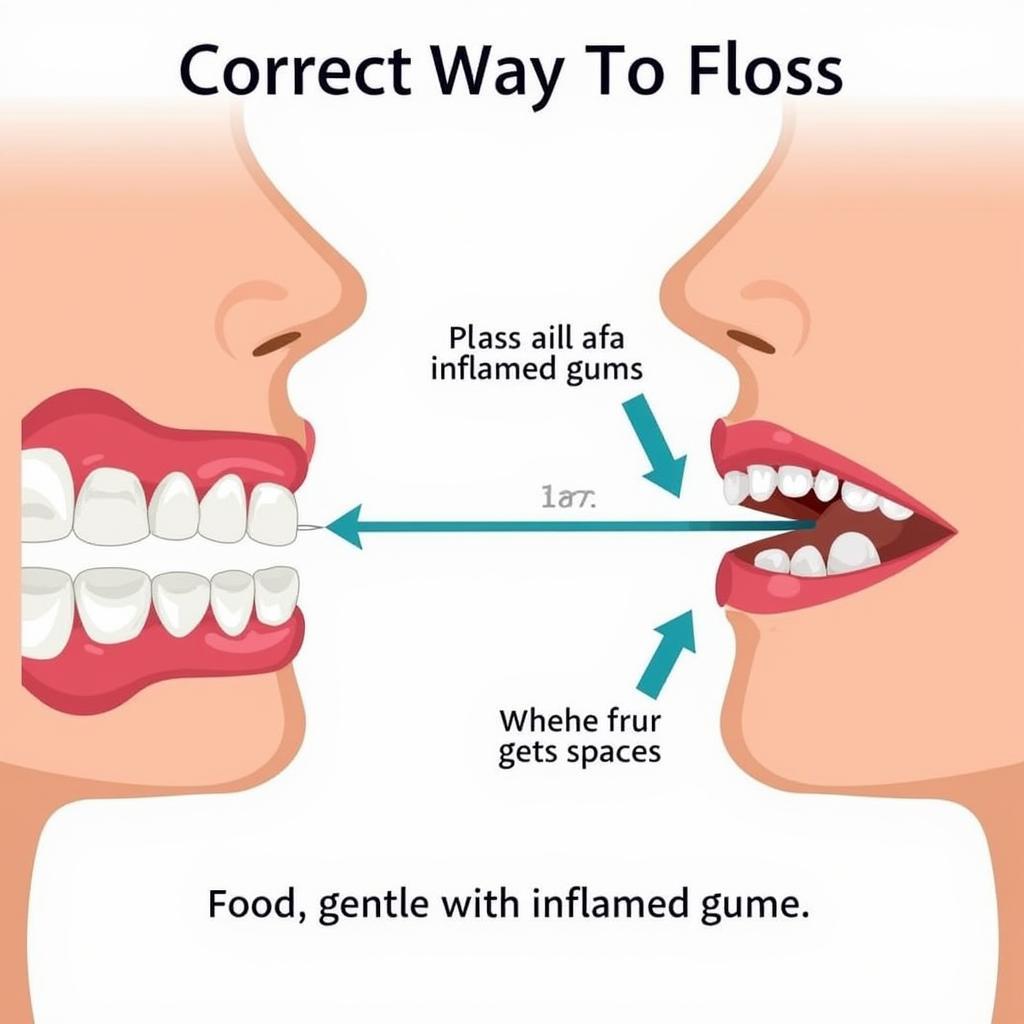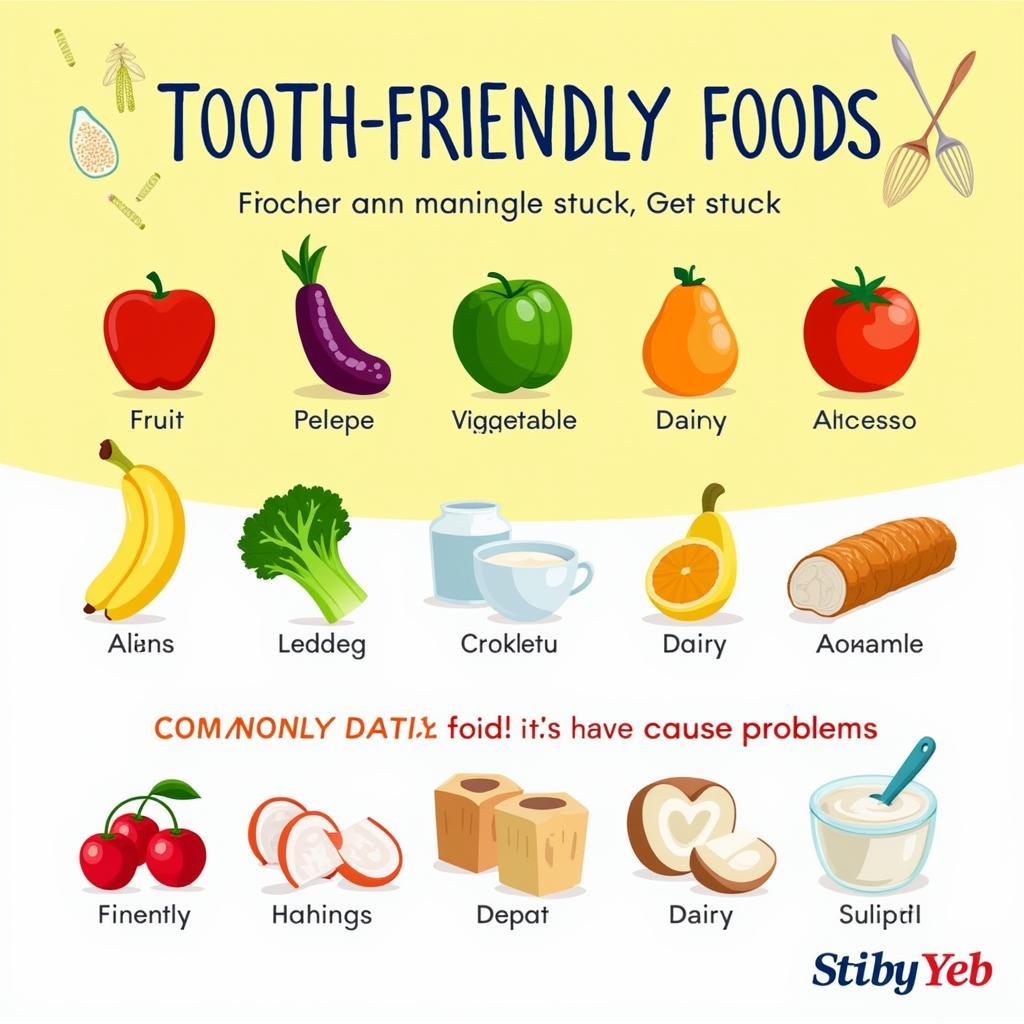Dealing with sore gums and food stubbornly lodged between your teeth is a frustrating experience. This common issue can range from a mild annoyance to a significant source of discomfort, especially when combined with gum inflammation. Let’s explore the causes, remedies, and prevention strategies for this irritating problem.
Understanding the Link Between Sore Gums and Trapped Food
Food particles trapped between teeth are a prime culprit for gum irritation. These trapped bits become a feast for bacteria, leading to plaque buildup, inflammation, and ultimately, sore gums. This can exacerbate existing gum conditions like gingivitis and periodontitis. Furthermore, if you’re experiencing gum pain from other causes, such as teething or an injury, trapped food can worsen the discomfort. If you are experiencing pain due to stuck food, you should seek professional dental advice. You may also want to consider other foods that are easier to manage when your teeth are hurting. See our article on foods to eat when your teeth hurt.
Effective Ways to Remove Trapped Food and Soothe Sore Gums
What can you do when food gets stuck and your gums are throbbing? There are several effective methods for removing trapped food and alleviating gum soreness.
-
Flossing: The gold standard for removing debris between teeth, flossing dislodges trapped particles and helps prevent further irritation. Use a gentle sawing motion to avoid damaging your gums.
-
Interdental Brushes: These small brushes are designed to clean between teeth, especially in areas where floss might struggle to reach.
-
Water Flosser/Oral Irrigator: A pressurized stream of water can effectively flush out stubborn food particles and massage sore gums.
 Proper Flossing Techniques for Sore Gums and Trapped Food
Proper Flossing Techniques for Sore Gums and Trapped Food
-
Rinsing with Salt Water: A warm saltwater rinse can soothe inflamed gums and help dislodge trapped food particles. Dissolve half a teaspoon of salt in a cup of warm water and rinse for 30 seconds.
-
Over-the-Counter Pain Relief: Ibuprofen or acetaminophen can temporarily relieve gum pain and inflammation.
-
Topical Anesthetics: Gels containing benzocaine or lidocaine can numb the affected area, providing temporary pain relief.
Why does food get stuck and cause pain? It can be due to various factors, including gaps between teeth, gum recession, or misaligned teeth. See our helpful resource on food stuck in between teeth pain.
Preventing Sore Gums and Food Trapping
Maintaining Good Oral Hygiene
Preventing sore gums and trapped food starts with consistent oral hygiene. Brush your teeth twice daily for two minutes each time, using a fluoride toothpaste. Floss daily, and consider incorporating an antimicrobial mouthwash into your routine.
Choosing the Right Foods
Certain foods are notorious for getting stuck between teeth. Limiting your intake of sticky, chewy, or fibrous foods, such as popcorn, caramel, and tough meats, can reduce the likelihood of food trapping.
Regular Dental Checkups
Regular dental checkups are crucial for maintaining optimal oral health. Your dentist can identify and address potential problems early on, preventing them from escalating into more serious issues like sore gums and periodontal disease.
 Healthy Food Choices for Preventing Sore Gums
Healthy Food Choices for Preventing Sore Gums
Addressing Underlying Dental Issues
Misaligned teeth, gaps, or fillings that have become worn or damaged can create spaces where food can easily become trapped. Addressing these issues with your dentist can significantly reduce the risk of gum irritation.
Dr. Emily Carter, DDS, emphasizes, “Regular dental cleanings and checkups are essential for preventing gum issues. We can identify early signs of gum disease and provide personalized advice to keep your gums healthy.”
Conclusion
Sore gums and food stuck between teeth are common but preventable problems. By practicing good oral hygiene, making smart food choices, and seeking regular dental care, you can keep your gums healthy and avoid the discomfort of trapped food. Don’t ignore persistent gum soreness or difficulty removing trapped food. Addressing these issues promptly can prevent them from developing into more serious dental problems. If you are experiencing persistent problems with Sore Gums Food Stuck Between Teeth, contact a dental professional.
FAQ
- How often should I floss? Ideally, once a day.
- Is it normal for gums to bleed when flossing? Occasional bleeding can be normal, especially if you haven’t flossed regularly. However, persistent bleeding should be addressed by a dentist.
- Can sore gums be a sign of something more serious? Yes, sore gums can indicate gum disease, infection, or other underlying health conditions. It’s important to consult with a dentist.
- What type of toothbrush is best for preventing gum problems? Soft-bristled toothbrushes are generally recommended for gentle cleaning without irritating the gums.
- What are the signs of gum disease? Red, swollen, or tender gums, bleeding while brushing or flossing, receding gums, persistent bad breath, and loose teeth are all potential signs of gum disease.
- Are water flossers as effective as traditional floss? Both methods are effective at removing plaque and debris. Consult with your dentist to determine which is best for your individual needs.
- Can certain medications contribute to sore gums? Yes, some medications can cause dry mouth or other side effects that can make gums more susceptible to irritation.
Common Scenarios
-
Scenario 1: You’ve just eaten popcorn and feel a kernel wedged between your molars. Try gently flossing the area. If that doesn’t work, use an interdental brush or a toothpick carefully.
-
Scenario 2: Your gums are sore and bleeding after flossing. This might be normal if you’re just starting to floss regularly. However, if the bleeding persists, see your dentist.
-
Scenario 3: You have persistent bad breath and your gums are often red and swollen. These are potential signs of gum disease. Schedule a dental checkup as soon as possible.
Further Reading and Related Questions
For more information on managing tooth pain, check out our article on “Foods to Eat When Your Teeth Hurt”. If you’re experiencing pain due to food trapped between your teeth, our resource on “Food Stuck in Between Teeth Pain” might offer helpful insights.
For any assistance or to book an appointment, please contact us at Phone Number: 02437655121, Email: minacones@gmail.com, or visit our address: 3PGH+8R9, ĐT70A, thôn Trung, Bắc Từ Liêm, Hà Nội, Việt Nam. Our customer service team is available 24/7.